- While several among them are avians, arachnids and seahorses are also capable of putting on a display — for hours, if need be.
- These displays are as varied and as impressive as the creatures which perform them: from moon walking to feather rubbing to produce a violin-like serenading effect.
Tap dancing birds, shuffling spiders, and wiggling honeybees; dancing is not just a human phenomenon. Many types of animals show off their moves for a variety of different reasons. By far the most common reason is to attract a mate. Dancing (usually done by the male) conveys important information about the animal’s physical status to a potential female mate. It’s also used by some animals as a general means to communicate. Unlike humans, very few animals dance to express their inner emotions (though there are some exceptions as well). These 10 animals are some of the most fascinating dancers in the entire animal kingdom. Their moves are particularly complex and interesting to watch.
#10. Blue-footed Booby
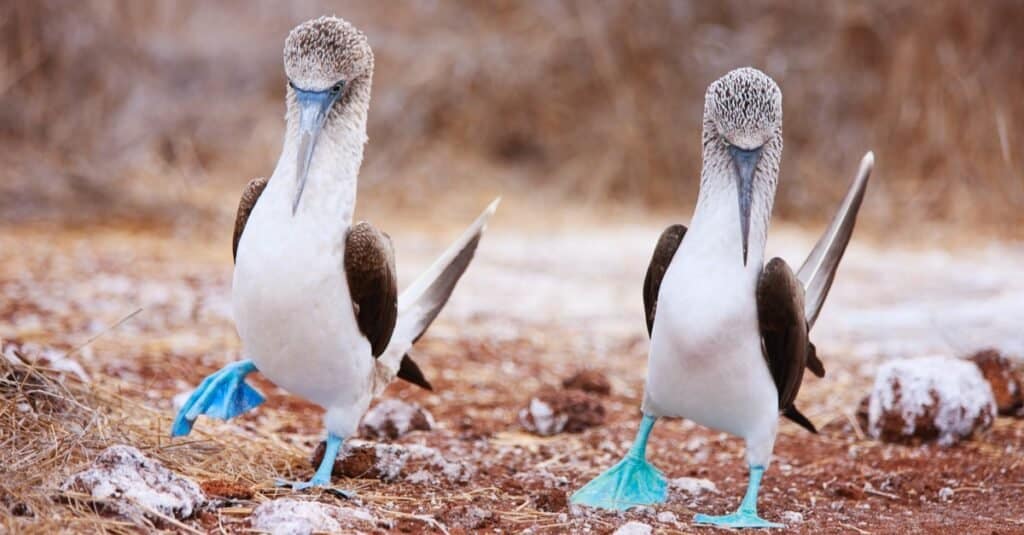
©BlueOrange Studio/Shutterstock.com
The fleet-footed blue booby is perhaps the master of the eccentric courtship ritual. Swathed in white plumage and brown wings, with additional brown streaks around the head, these large marine birds can be found throughout the eastern Pacific Ocean, from the coast of California to Peru; around half of all mating pairs congregate together around the Galapagos Island.
In order to attract a mate, the male will strut around, first lifting one foot and then another. He will then extend his wings outward and point his head up at the sky: this maneuver is known as sky pointing. Once the male has found an appropriate mate, they will tend to remain bonded for life, raising successive broods every year. This does not necessarily stop them from engaging in the occasional trysts with other partners, however.
#9. Peacock Spiders

©iStock.com/crbellette
These small jumping spiders, which measure no larger than a grain of rice, love to strut their stuff in front of a potential mate. Just like the preening bird for which it’s named, the male peacock spider is swathed in iridescent blue, yellow, and red markings on the upper part of the abdomen, which he can raise up above his head like a peacock tail.
When it meets a female spider, the male will wave his raised abdomen and two of his legs in the air and move his body from side to side. He also has the ability to create a powerful vibration that the female can feel straight through the ground. She prefers a smooth and consistent rumble. If she’s not impressed with what the male is offering, then the courtship may end prematurely in cannibalism, with the female consuming the male. This makes the courtship dance a dangerous, high-stakes affair. There are more than 80 documented species of peacock spiders from around the world, and most of them seem to engage in this strange and elaborate dance.
#8. Seahorse
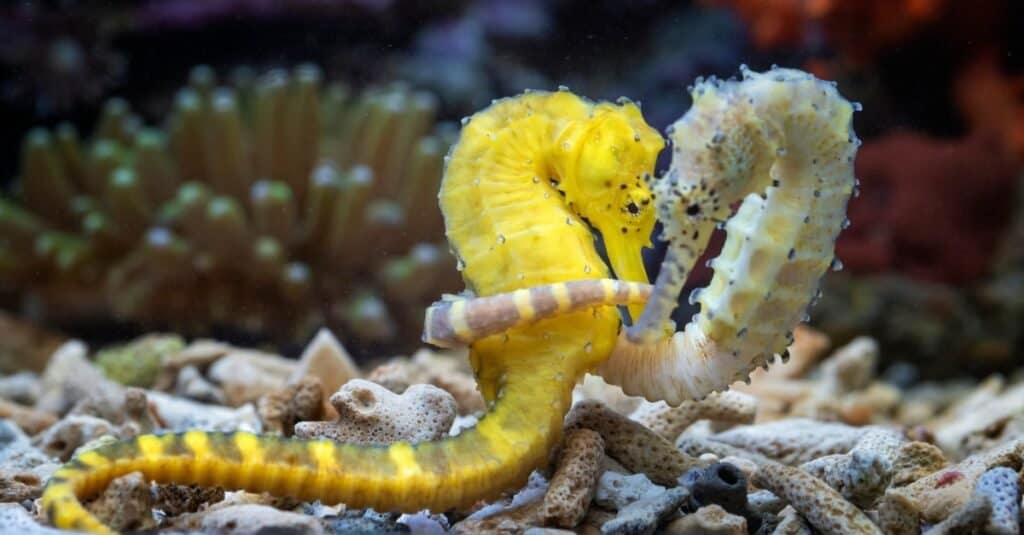
Two Seahorses, with their tails entwined, during their courtship process.
©Bernard S Tjandra/Shutterstock.com
The seahorse (a type of ray-finned fish which is one of the animals that dance) has a long and elaborate courtship process, marked by synchronized movements and physical changes. Every day around dawn the seahorses will come together, brighten their bodies, and start to quiver. Then they will entwine their tails together and swim in circles for several hours. If successful, the courtship process will result in fertilization.
Curiously, the seahorse is one of the few animals in which the male becomes pregnant. The female has a long tube through which she can deposit her eggs within the male’s pouch. He will then carry the offspring (as many as a few thousand of them) to term after a three-week gestation period. There are some 46 species of seahorses, each with its own idiosyncratic twist on this process.
#7. Birds of Paradise
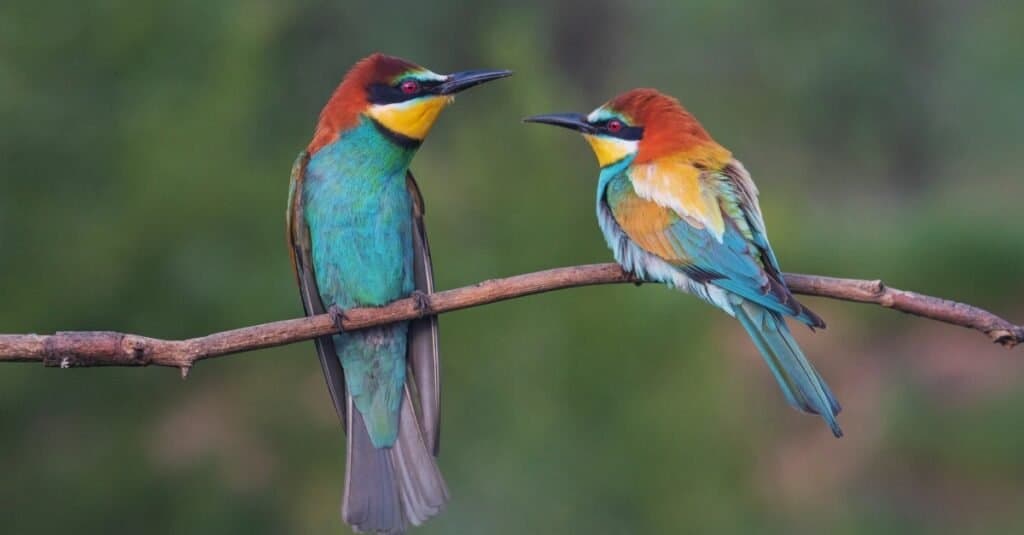
©iStock.com/drakuliren
Native to the dense tropical forests of the Asian Pacific region, these beautiful birds of paradise (there are 46 species within the family) come in all kinds of exquisite colors and strange shapes. One of the most interesting courtship strategies (shared by many other birds in this article) is called lekking. It involves a concentrated group of males who show off their best stuff so the female can quickly survey which one she wants to mate with.
Not every bird of paradise creates a lek, however. The Victoria’s riflebird, which may take the prize for the most bizarre courtship display, has a far more personal touch. After attracting a mate with his raspy call, the male will tilt his head back and stiffen his brightly colored throat feathers to accentuate their strange beauty in the gleaming sunlight of the rainforest. He will then raise his massive wings for the females to see, first one wing and then another while hopping from side to side in a bid to impress her.
Another species called the six-plumed bird of paradise, adorned with six massive head quills, is equally as strange. The male will meticulously clean a patch of forest to prepare for his show. Once a female arrives, he will hop around like a ballerina with his hood-like throat feathers extended. If he succeeds, then the female will mate with him and then depart to raise the chicks on her own.
#6. Manakins
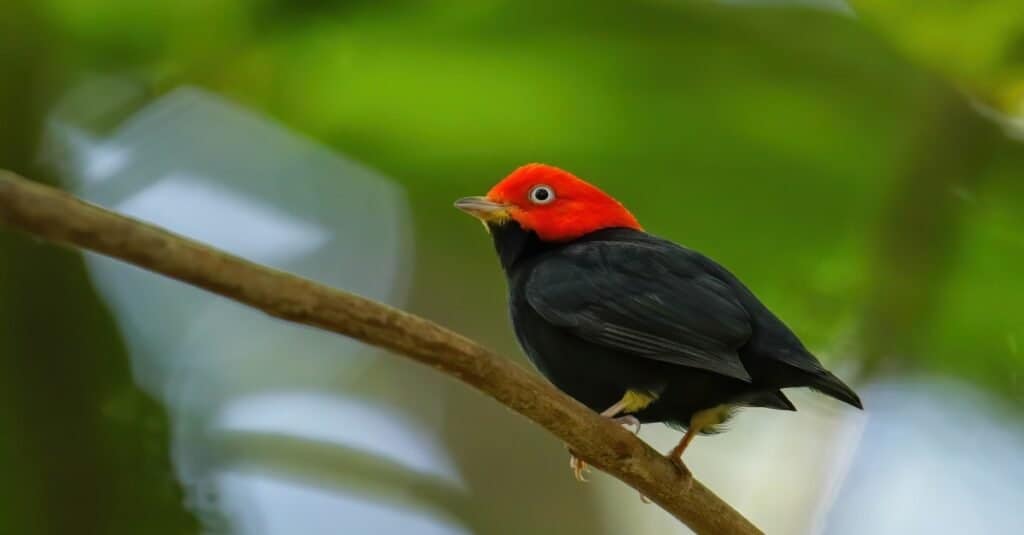
©Don Mammoser/Shutterstock.com
The manakin is a family of small songbirds, comprised of 54 unique species, native to the American tropics. Males have exaggerated physical characteristics and bright colors to help them attract a mate. Like the birds of paradise previously mentioned, the male manakins also create individual display areas called leks, where they may dance or even moonwalk, so the females can evaluate their moves and choose a suitable mate.
One of the most fascinating behaviors comes from the club-winged manakin, which can rub its feathers together like a musical maestro to produce a violin-like sound in a similar manner to a cricket. If the female is impressed by these displays, then she will join the male in an erratic series of intense flights that excite her.
#5. Red-crowned Crane

©Ondrej Prosicky/Shutterstock.com
A symbol of luck, faithfulness, and longevity in some cultures, the red-crowned crane is a long-necked wading bird from East Asia. It is characterized by a white body, black neck and rump, and, of course, the red crown on the head. Their elaborate courtship ritual involves a stunning duet to establish and strengthen its pair bond. The two birds will move together in rhythmic synchronization, wings extended outward and fluttering until they’re standing close. Then they will throw back their heads and let out a loud call in unison. This call may trigger other pairs in the area to start their own dances as well. While cranes only mate once per year, this dance can occur at any time.
#4. Flamingoes

©FilippoPH/Shutterstock.com
The flamingo is a family of pink wading birds whose massive colonies are a cacophony of honking and grunting. There are currently six living species distributed all over the world.
These include the Andean flamingo, the Caribbean flamingo, the Chilean flamingo, the greater flamingo, the lesser flamingo, and the puna flamingo.
Before breeding, smaller groups of up to 50 birds will split off from the main colony. These flamingos will run together with necks held straight out and bills pointed upward.
Males also learn their own individual moves; they will flash their wings and bow their heads to impress a mate. There are more than 100 moves total, which takes many years to learn and master. This dance may signify important information about the physical status of the flamingo because the female tends to choose the mate with the most complex moves. Some flamingoes will mate for life, but it’s not uncommon for them to keep multiple partners around.
#3. Sharp-tailed Grouse
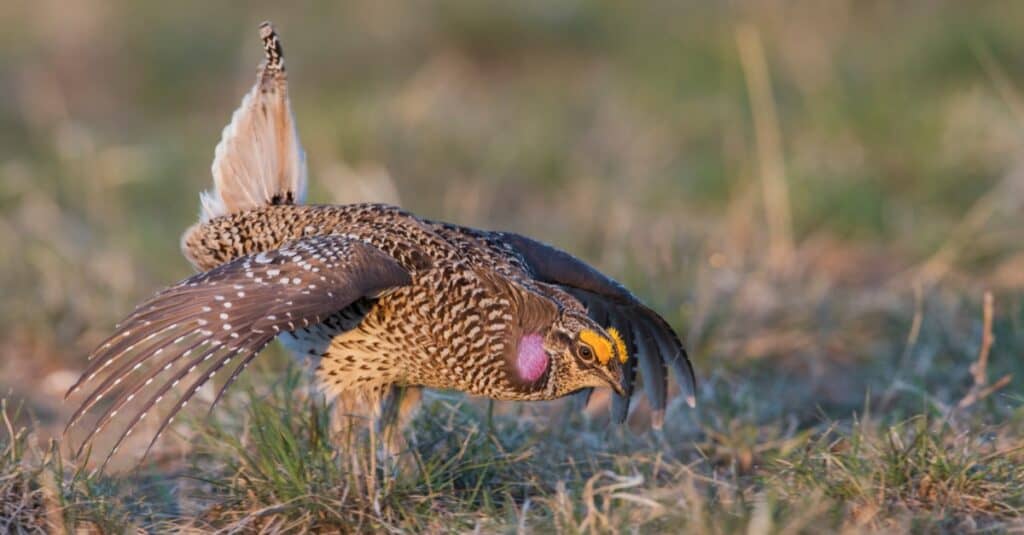
©Danita Delimont/Shutterstock.com
Another of the animals that dance, is the Sharp-tailed Grouse. These medium-sized prairie birds are native to the western parts of Canada and the United States. In the spring and summer mating season, up to 20 males will gather together in leks at dawn and begin their intense courtship display. Looking a bit like mechanical windup toys, the males will rapidly stamp their feet together up to 20 times a second while turning in circles. At the same time, they will rapidly inflate and deflate their purple neck sacs, which may help to amplify the courtship call and signify overall health. The female will choose the most impressive and dominant males to mate with.
#2. Grebes
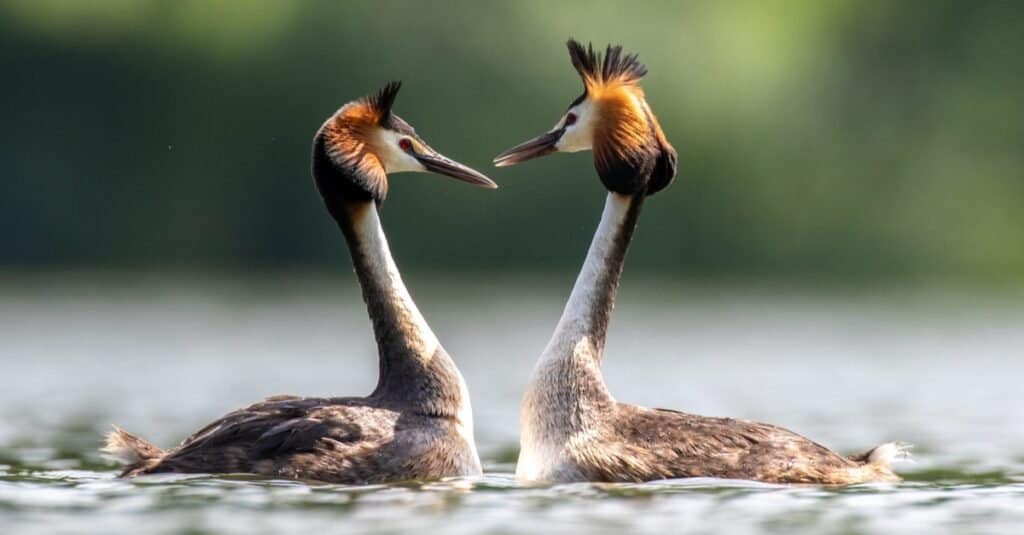
©iStock.com/DenisVesely
The grebe is a family of aquatic diving birds from the Americas with a long neck and thin, sharp bill. They are also animals that dance. Both the Clark’s and western grebe, which both belong to the same genus, have a similar courtship behavior in which the male and female will run across the surface of the water together in perfect synchronization with their wings outstretched and their heads raised. Their movements look so precise and dainty that it’s difficult to believe a human ballerina could do it better.
#1. Honeybees
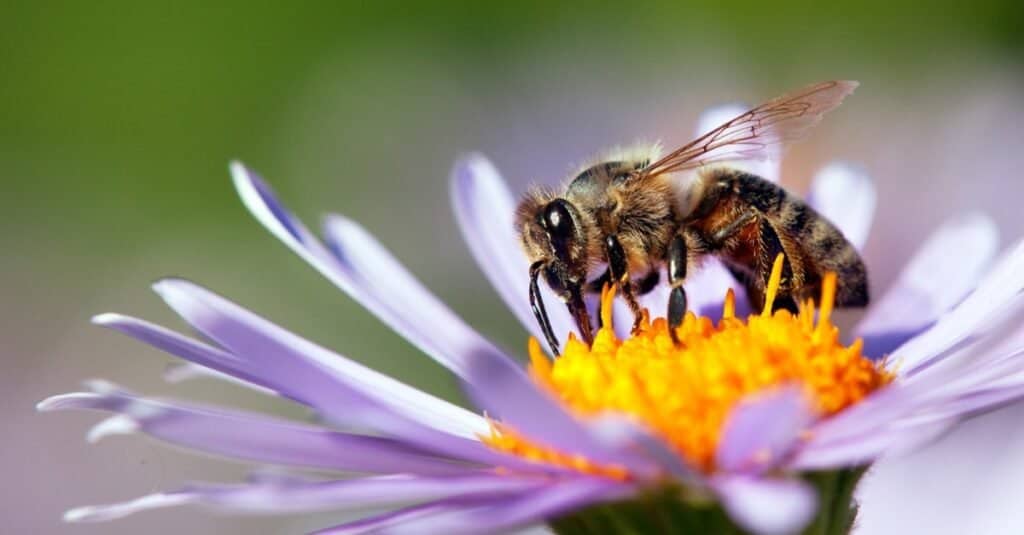
©Daniel Prudek/Shutterstock.com
Other animals that dance, are worker honeybees. They are impressive dancers. Upon returning to the nest, they can communicate both the location and direction of a food source to the rest of the colony just by wiggling the abdomen in a precise manner. The orientation of the movement is thought to signal the position of the sun in relation to the food source, whereas the length of the dance communicates the distance from the hive. While almost all honeybees dance, each species has its own unique style.
Up Next…
Keep reading these posts for more incredible information about key animal facts.
- The 9 Most Interesting Animals in the World: Animals that seem like two morphed into one, those capable of detecting electrical fields, those with regenerative capabilities and suspected immortality. Find out more about these marvels of nature here.
- Discover the 10 Most Beautiful Birds in the World: These avians come in feathery finery which sets them apart from the rest. Click on the link to discover just how wondrous they truly are.
- 15 Animals on the Appalachian Trail: It starts in the South and ends in the North. But during that 6-month trek from Georgia to Maine you’ll get to see some of the most beautiful wildlife in the world. We’ve listed them here so you can know just what to expect.
- 7 Unbelievable Animals That Hunt By Shooting Their Prey: Discover the animals that hunt their prey by shooting.
The photo featured at the top of this post is © iStock.com/plusphoto
Thank you for reading! Have some feedback for us? Contact the AZ Animals editorial team.






